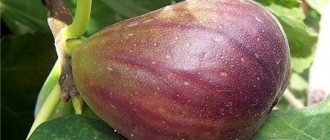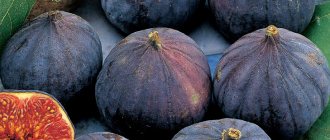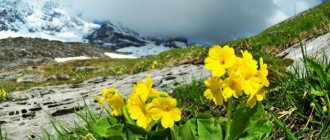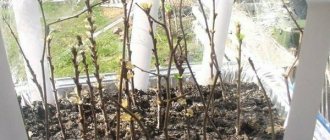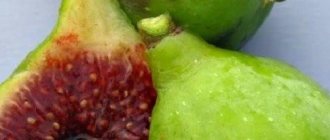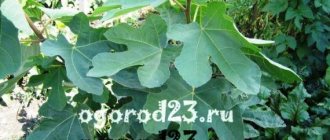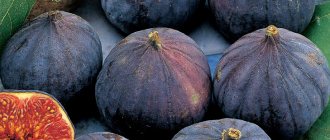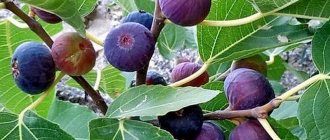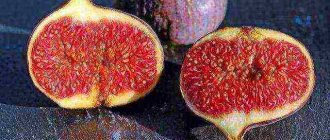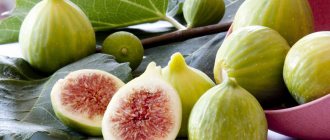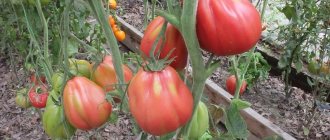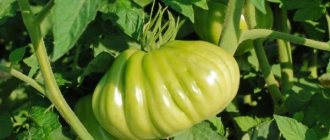Features of spring cuttings
In order to plant strong cuttings in open ground, you need to take only 2-year-old seedlings. The land should be well fertilized. Features of planting in the spring season are the following:
- the diameter and depth of the planting hole should not exceed 1 m;
- a mandatory aspect is laying drainage at the bottom of the pit;
- a mixture of soil and bone meal is laid out on top of the drainage;
- The seedling must be planted with a pre-straightened root system;
- abundant watering of seedlings and mulching.
The procedure for transplanting seedlings to a permanent place
For planting in open ground in a permanent place, only two-year-old seedlings that have at least two lateral branches are suitable. They will take root much better in the garden and will begin to bear fruit faster.
Figs are quite unpretentious to the soil in which they will be grown. Rocky soil, sand, and clay are suitable for planting it. But the soil in the planting hole will need to be fertilized first, using organic bait or a special soil mixture.
A fig tree seedling is planted in the ground as follows:
- A planting hole is dug with a diameter and depth of 1 meter.
- Drainage made of crushed stone, gravel or broken brick is laid at the bottom of the pit.
- The top of the drainage is covered with a mixture of soil, bone meal and rubble stone.
- A seedling with a pre-straightened root system is placed in the hole, tightly covered with earth and compacted.
- The planted tree is watered abundantly, and then its trunk circle is mulched.
Figs can be planted in the garden using the trench method. In this case, it will grow in the form of a bush and take on a decorative appearance. The algorithm of actions will be the same as when planting it in a hole - separate holes will also form at the bottom of the trench. Only the seedlings will be placed in them at an angle of 45 degrees and tied to the supports.
Caring for a fig tree planted in the ground will be the same as caring for any other fruit plant, even such an exotic one as the outlandish Black Prince apricot.
It will consist of regular moderate watering - 2 times a week after planting, periodic feeding - once every three weeks, timely pinching of young shoots, autumn pruning, removal of dry shoots, construction of a shelter for the winter.
Despite the fact that figs are considered a rather unpretentious tree, the rules of regular care cannot be ignored. Regardless of whether your fig tree is grown from a seed or a cutting, proper care will provide it with a beautiful crown, dense greenery and a large harvest of sweet fruits.
240
Rules for grafting figs
A popular procedure among gardeners is propagation of figs by cuttings in the spring. Gardeners often propagate fruit trees in this way. To graft a plant means that a branch no more than 10 cm in length and necessarily growing vertically is added to a ready-made tree that bears a harvest, with similar varietal characteristics.
There should be no leaves or flowers on the shoot. The thickness of the branches must be identical in order for the tree to grow together. One way is to simply connect 2 branches and wind them tightly. This method is simple at first glance, but it is difficult to vaccinate in this way due to the possibility of rejection.
You can also graft under the bark; this method is used when the shoot is smaller than the branch. An incision is made in the tree branch into which the shoot is inserted. Then there is tight wrapping and covering with plasticine.
Expert advice
It is important to treat all plants with love and grow seedlings with special care. It is necessary to follow the rules of systematic watering and hilling. It is important to fertilize the plant periodically. Grafted branches need special care. With the right approach and following all recommendations, there will be a 99% guarantee of a fruitful fig tree in the garden.
It is necessary to fertilize homemade figs with rooted stems when they bloom and form fruits. Organic and mineral compositions are suitable for it. The fig tree responds well to the following fertilizers:
- infused slurry;
- wood ash;
- weed fertilizer.
They are introduced with a break of 2 weeks. It is worth feeding the tree at the beginning of the growing season. When its buds begin to wake up, the fig is watered with infused manure. After 2 weeks, liquid mineral fertilizer containing a lot of phosphorus and nitrogen is applied. The color of fig leaves will be brighter and more saturated if you fertilize it with iron sulfate. They do this twice a year - in spring and summer.
Figs are a curiosity in a summer cottage
Amateur gardeners began to plant fig trees, savory trees, and figs in their summer cottages quite recently. When the majority of the population became aware of its beneficial properties and ease of reproduction, its popularity increased hundreds of times. Figs are a very beautiful tree with unusual fruits, which encourages gardeners to increase their number on the site.
I’m not going to dissuade stubborn romantics who are ready to make even Mars green, but realistically speaking, it’s safer to hide figs from the subtropics for the winter in a veranda, or even grow them in a greenhouse. This is the only way to be sure that the “Imported Plant Varieties” party will not end at any time during the colder winter.
Figs are not picky about the method of propagation: jigging, cuttings, seeds, root shoots. The main thing that can affect this process is low ambient temperatures.
What are figs and the benefits of growing them?
The fig or fig tree is a fruit tree native to the subtropics. Its dietary fruits are incredibly beneficial for our health, not only in fresh, but also in dried form. They contain a huge amount of vitamins and other useful substances that are so necessary for our body to maintain the functioning of all its organs and systems.
Some 20 years ago, figs began to be grown in the Krasnodar Territory and Crimea, but today the fig tree grows successfully in private gardens in central Russia. It perfectly dilutes the overall appearance of the garden plot and, with proper care, pleases gardeners with a harvest of its sweet and healthy berries.
The benefits of planting a fig tree are obvious:
- Any soil is suitable for this fruit tree.
- The harvest can be harvested twice during one season - in mid-summer and autumn.
- With proper care in winter, figs can withstand 20 degree frost.
Fig tree
There is nothing difficult in growing a fig tree; even a novice gardener can cope with planting and caring for it. Global warming and advances in global selection make it possible to grow not only figs, but also such southern fruit plants as persimmon, peach, pomegranate, etc. in our country’s garden plots.
Before planting this tree in your garden, you need to decide on the variety. Modern breeders have bred several dozen of them. They differ in frost resistance, yield, timing of fruit ripening and their taste. The following fig varieties are best suited for growing in gardens in central Russia:
- Dalmatian.
- Crimean black.
- Nikitsky.
- Brunswick.
- Sochi No. 7.
- San Pedro et al.
Surprisingly, this plant lends itself well to propagation at home. There are even several ways to do this. More details about them in our next sections.
Fig propagation methods
Lignified cuttings (methods for harvesting, storing and rooting lignified cuttings are described in detail here).
This type of propagation involves harvesting cuttings in late autumn and storing them for planting in early spring. To do this, select a branch from a tree with a diameter of 1-1.5 and a length of 20-30 cm. It will be perfectly preserved if placed in sand and placed (for example, a box) in a cool place. If you simply have nowhere to store it, you can wrap the cuttings in thick, thick cloth and bury them in the ground to a depth of up to half a meter. You must first pour sand into the hole (natural intake of excess moisture).
In mid-spring, around April, the cuttings are dug up and prepared for planting in open ground. Before planting, dig a hole deep enough to fit 2/3 of the cutting inside.
After a long period of storage, the cutting needs to be cut off a little on the bottom side and from the cut to a height of 10 cm, make a few scratches with a sharp object. This procedure is necessary to quickly take root in different places, so that the cutting is securely anchored in the soil and constantly receives the necessary substances for normal growth.
When the cutting is placed in a hole, it is covered with earth with the addition of a small amount of rotted manure. The top of the cutting in relation to the ground level should look no higher than 8-10 cm.
Green stalk. This method is a little faster, but requires compliance with the necessary rules. To do this, a piece of branch is cut from an established tree. There should be at least 4 internodes on the cutting.
When harvesting occurs in the summer, the lower leaves on the cuttings are cut off so that approximately 7-10 cm of bare cuttings remain. The upper part is also cut off, but with the caveat that at least 3 internodes remain on it. Naturally, after being cut, the cutting secretes its own juice and in order to prevent it from drying out completely, it is left to dry in the fresh air for a couple of hours, and then the lower part is dipped in clean ash.
After dipping, the cuttings are planted in a pre-prepared mixture of sand and fertilized soil. To prevent drying out or slight frostbite, at first the cuttings are covered with a special “breathable film”.
Method - layering. The method is the simplest and does not require much effort and constant supervision. But there is one condition - branches from the root system.
The principle of such propagation is that a trench is dug near the shoot (20-30 cm deep), nutritious soil is placed at the bottom and watered. Next, the shoot is placed in it and covered with earth.
After this, the area is watered abundantly and all you have to do is wait until the shoot takes root and “brings up” a shoot for a new tree.
Methods and technologies for planting in open ground
Since it is unlikely that it will be possible to grow a full-fledged tree in low temperatures, figs can be propagated by properly organizing their planting in open ground. For permanent planting, two main methods are used - trench planting and hole planting.
Trench planting
The method of planting in a trench makes it possible to ensure normal growth of the plant and its formation in the form of a perennial bush. For planting, a trench 1-1.2 meters deep is opened. The walls of the trench are made of different slopes: the northern one is steep with an inclination angle of 85-90 degrees, the southern one is up to 30 degrees. This is due to the fact that in the spring, with such steep walls of the trench, the soil warms up better.
The sediment is made into holes 50-60 cm deep at the bottom of the trench. The bottom is covered with expanded clay or broken brick.
Attention! Crushed concrete cannot be used for drainage; it negatively affects the root system of the fig tree.
Trench planting of figs
The drainage is sprinkled with a 4-5 cm layer of sand and a soil mixture of earth and sand in a ratio of 3:1. The seedling is removed from the container and placed at the bottom of the hole. The hole is filled with a mixture of earth and sand. Later, it is recommended to strengthen the northern wall with brickwork using clay mortar - this will improve the drainage of the trench and provide oxygen access to the soil. The distance between plants in the trench is 0.8-1 meter.
Planting in pits
When planted in holes, the bush is formed in a depression relative to the main surface of the soil. The diameter of the pit is 1.2-1.5 meters, it is preferable to make the slope of the walls the same as in the trench method. The bottom of the planting hole is made with drainage, and the walls are lined with brick or sandstone. After planting, the under-barrel part is mulched.
Cuttings and rooting of figs
#1 Lana
- Moderators
- 1,791 messages
- My name is Svetlana
- Floor:
- City: Moscow-Moscow region
I want to prune the figs - those branches that are now bearing fruit. It would be a shame to throw away such material. How to root fig cuttings, and are all branches suitable for this?
Answer:
All branches are suitable. Figs take root easily even in water.
And it doesn’t matter - in spring or autumn?
#2 Jah
- My name is: Boris
- Floor:
- Chelyabinsk city
- Collection: view
There is a difference. In spring the plants will be stronger. And before winter, leaves from the cuttings may fall off, and new ones may no longer grow.
It will give roots, but will not have enough strength to grow leaves, and after sitting for a couple of months, it will die
Sadly. But I’ll try anyway - maybe something will survive?
#3 Odina
- My name is Olga
- Floor:
- City: St. Petersburg
- Collection: view
Propagation by cuttings. The method of propagating figs by cuttings is the most accessible, fastest and most reliable. The varieties most adapted to indoor conditions, already tested by amateurs, and producing the highest yields of tasty and large fruits are propagated by cuttings. The mother plant from which cuttings are taken must bear fruit for at least 5 years, be well developed, produce large fruit of good quality and taste, bear fruit abundantly and, finally, have a relatively small (dwarf) stature.
In areas where figs grow in open ground, the best time for taking cuttings is considered to be autumn - the period of natural leaf fall. Harvested cuttings are stored in special trenches. In indoor cultivation, cuttings are harvested immediately before planting them in the ground, that is, in spring and summer. In the spring, cuttings are cut before the next vegetation (growth) of plants begins, in the summer - at any time from June to August.
Figs propagate equally well from both green and woody cuttings.
All excess (internal, lateral and vertical) shoots of the mother plant are cut into rings with pruning shears or a sharp garden knife, and those of the lateral and vertical shoots that have strong growth and can change the shape of the bush in an undesirable direction are shortened. When pruning, lateral branches are left with 3-5 eyes, and vertical branches are left with 5-7 eyes. The cut on the side branches is made perpendicular to the axis of the branch at a distance of 2-3 cm from the bud; on vertical shoots, the cut is made obliquely at an angle of 30-35° to the axis of the branch at a distance of 1-2 cm from the bud, and the direction of the cut should be towards the bud, so that the moisture that gets on the cut flows not towards the bud, but from it.
All sections are covered with garden varnish, oil paint diluted with natural drying oil, or, in their absence, sprinkled with coal dust.
Cut branches are placed with their lower ends in warm water with a temperature of 26-28° for 10-16 hours. You can also recommend testing growth stimulants (soaking in a 0.001 percent heteroauxin solution for 10-12 hours).
After soaking, the branches are cut with a sharp knife into cuttings with 2-3 eyes. The number of eyes depends on the distance between them. The length of the cutting should be at least 5-7 cm and no more than 10 cm. The lower cut is made perhaps closer to the lower bud and perpendicular to the axis of the cutting, and the upper cut is 1.5-2 cm above the upper bud at an angle of 30- 40° with the cut direction towards the kidney. Several longitudinal scratches are made on the bark at the bottom of the cutting up to the cambial layer; This causes better and faster formation of callus (influx) and root tubercles in fig cuttings.
The cuttings are planted in a checkerboard pattern in a slightly inclined position, for every 10 cm2 of greenhouse - one cutting. For ease of planting, it is useful to make a hole in the ground with a wooden stick or just a pencil, which is leveled after planting the cutting. The lower bud is immersed in sand no more than 1.5-2 cm and no less than 1 cm.
After planting, the cuttings are watered with warm water from a garden watering can or a spray bottle. The greenhouses are covered with glass, and the flower pots are covered with glass or paper glasses and placed in a warm and not necessarily bright place. The ground temperature during the rooting period should be between 20-24°.
After the formation of the third leaf, the plants gradually begin to adapt to the conditions of the room. To do this, at first, raise the glass (or glasses) during the day for 1-2 hours, gradually increase the time spent without shelter, and after two or three weeks, completely remove the caps or glass.
Simultaneously with “hardening” the plants, it is useful to feed them with a 0.25 percent solution of saltpeter, which is applied once every ten days at the rate of 100-150 cm3 (half a glass) of solution per 1 kg of soil. Before applying the nitrate solution, the soil must be moistened with water. When fertilizing, you need to ensure that the solution does not get on young plants.
From the second half of summer (in July), the nitrate solution is replaced with a 10% solution of slurry, which is applied once a decade at the rate of 200-250 cm3 (glass) per 1 kg of land.
If rooted cuttings produce significant growth, they must be transplanted from the greenhouse into flower pots with a top diameter of 12-15 cm. Rooted cuttings in smaller pots must be transferred (transplanted without disturbing the earthen coma) into pots also with a diameter of 12-15 cm. During transshipment or replanting, sand is replaced with earth and the drainage layer is replaced.
Practice has shown that fig cuttings take root well in the ground in the summer, even without covering with a canopy. Some hobbyists root cuttings in a glass of water and, when roots appear, plants are planted directly in pots with a top diameter of 12-15 cm.
